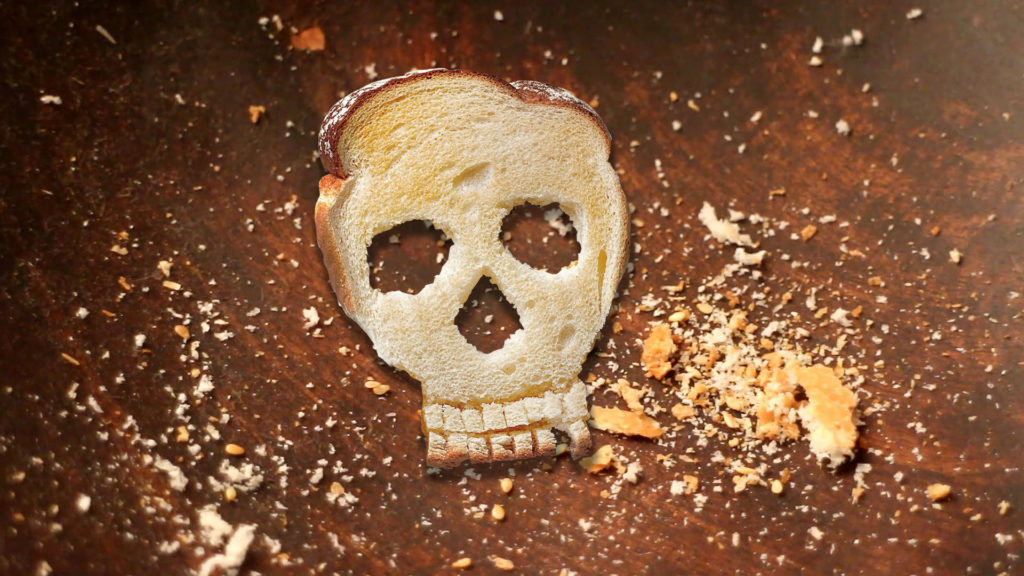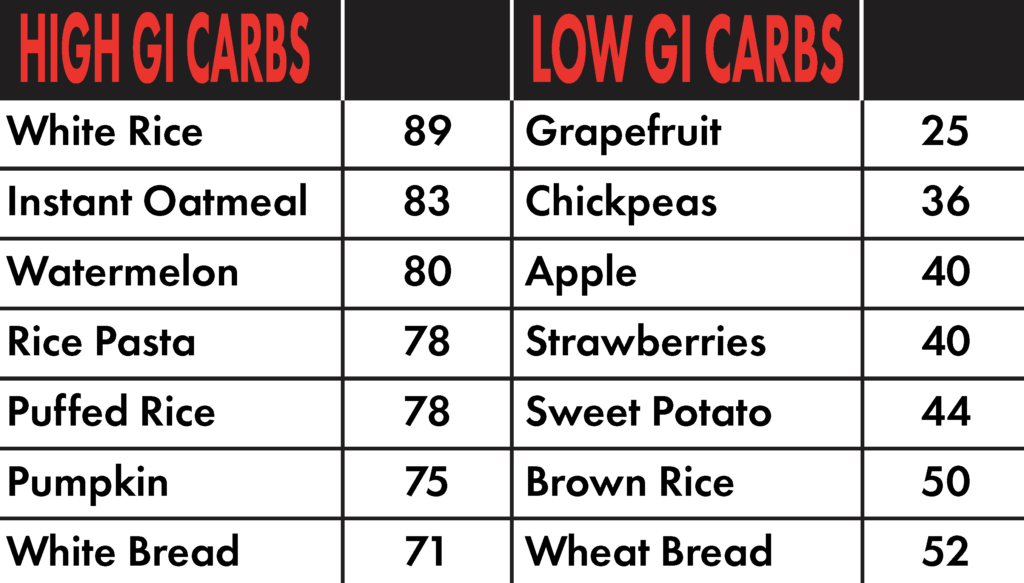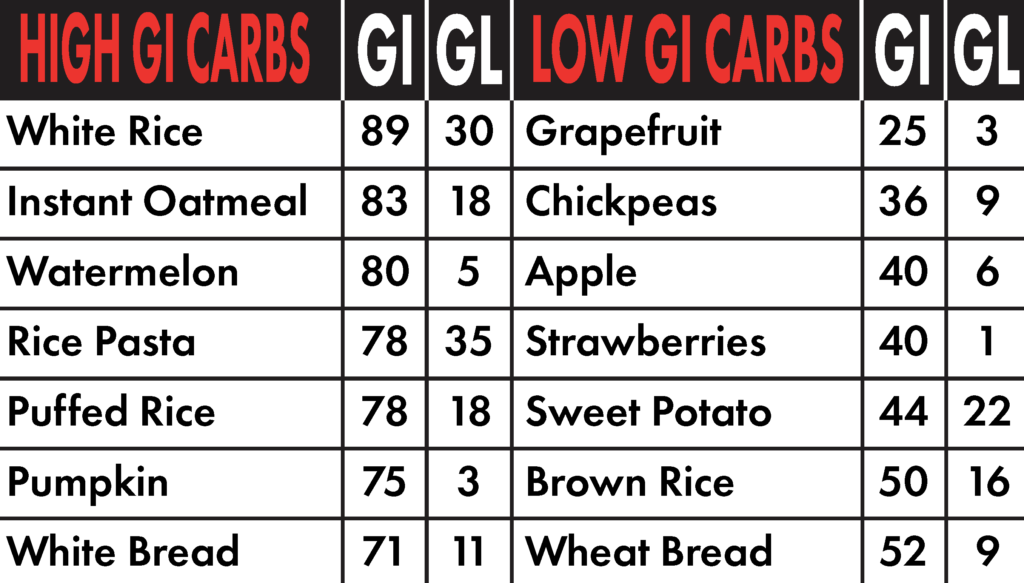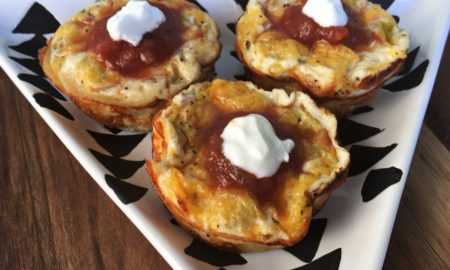
Bread is often vilified when it comes to reducing fat, building muscle and overall health, but is bread really all that bad for you? We’ve been eating bread for thousands of years, yet, millennia later, it’s basically considered death by the slice. What gives?
Popular eating plans gives–that and the way we make bread nowadays.
Low Carb, Keto, Atkins, you name it, along with bread made to have a long shelf life instead of delivering nutritious carbs, and it’s easy to jump to the conclusion that bread is awful for you. The truth is, it isn’t black-and-white when it comes to bread.
Think Bread Glycemic Index
Bread is not the enemy so much as its glycemic index (GI). This holds true even when comparing white bread to whole wheat, and even when compared to other foods not sold at a bakery.
GI is a rating from 0-100 of how much a carb will affect blood sugar. The higher the number, the higher your blood sugar spikes and forces your body to release insulin to mitigate it.
Low = 0-55
Medium = 56-69
High = 70-100
T.H. Chan from the Harvard School of Public health said, “Eating many high-glycemic-index foods–which cause powerful spikes in blood sugar–can lead to an increased risk for type 2 diabetes, heart disease, and [becoming] overweight.” Basically high glycemic foods lower performance and health in “most” cases.
Generally, you and your body want low. The lower the GI, the slower you digest, absorb and metabolize it, and the easier it is on your body. However, as an athlete, you have specific needs, and they’re not all that complicated. It’s all about timing.

Glycemic Load: The Other Half of This Whole Carb Thing
Glycemic index is a fairly familiar term for those who are conscious about what they put in their body every day. There’s one other factor that comes into play: glycemic load (GL). GL is simply how much a food item will raise your blood sugar per serving.
Low = 0-10
Medium = 11-19
High = 20+
For all you math lovers out there, here are two examples of GL:(1)
1. The Glycemic Load (GL) of a potato (GI around 90) containing approximately 18 grams of carbohydrate is 18 x 90% = 16.
2. The GL of an apple (GI around 40) containing approximately 15 grams of carbohydrate is 15 x 40% = 6.
Catherine Saxelby explains the math by saying, “The potato will produce a blood sugar rise three times that of the apple. When foods have similar amounts of carbohydrates, GI will have the greatest influence on blood sugars. When the amount of carbohydrate in a portion differs the best way to predict blood sugar effects will be via the GL.”
For all you non-math people: low GL is good most of the time. And yes, someone’s already done all the math and put quite a few food items in a useful chart (see link in next section).
Carbs Athletes Need
You actually need a mix of low and high GI carbs: low for a steady supply of energy your muscles can use, and then high GI carbs for recovery. You want just the right amount of low GI carbs to minimize creating a scenario where your body goes catabolic and starts eating away at its own muscle mass for energy. The high GI carbs have the same effect.
Sydney University made this useful chart if you’re looking for an easy way to figure out a food’s GI and GL. However, for some quick references, here’s a couple of charts that might surprise you.

Interestingly, how you cook certain foods, including potatoes, has a dramatic effect on the GI of a food, but here’s the thing: using just a food’s glycemic index to gauge how it’ll affect your blood sugar levels is outdated. GI doesn’t take serving size into consideration.
Here’s a look at those same foods and their glycemic load:

Once you put the serving size into focus, the GI of many foods isn’t as bad as it looks. While they’ll raise your blood sugar faster, in the end, they won’t raise it all that much. What makes such a huge difference?
- Fiber
- Processing
- Ripeness
- Fat & acid content
Fiber acts as a great equalizer, slowing down the conversion of the carbohydrate to glucose. Processing usually strips away fiber and other nutrients, making it easier to spike blood sugar levels. When it comes to ripeness, riper produce are higher up on the glycemic rating. And finally, fatty and acidic meals are slower to be converted to sugars.
Glycemic Numbers and Weight/Fitness
Research so far shows a trend that both insulin resistance and insulin secretion play a role in body weight regulation. A pilot study published in the American Diabetes Association said, “Healthy overweight women and men with relatively greater insulin secretion in response to a standard oral glucose tolerance test lost more weight when assigned to a low–glycemic load hypocaloric diet than to a high–glycemic load diet.”
When it comes to weight management, the bottom line is counting calories, making sure every last calorie counts nutritionally and glycemically.
“Results of a 16-year study that tracked the diets of 120,000 men and women were published in 2015. Researchers found that diets with a high GL from eating refined grains, starches and sugars were associated with more weight gain.”
Now, you are either completely confused or it is one of those AHA moments where you understand Glycemic Load is actually more important than Glycemic Index the majority of the time. So lets cut to the chase of what carbohydrates you should consume to achieve optimal gains. You want low glycemic before and high glycemic after to maximize performance, recovery, and growth.

Height, weight, age, gender, genetics and so on all affect what your body needs nutritionally. The best way to determine the optimal diet is blood work. Still, here’s what research is able to show so far:
In a study on the glycemic index and athletic performance published in the ACSM Health & Fitness Journal, researchers compared low- versus high-glycemic-index meals on time trial performance in eight male cyclists. They found that time trial performance was significantly improved in the low-glycemic index trial compared with the high-glycemic index trial.
Researchers concluded that “The improvement in time trial performance for the low-glycemic index trial may be associated with an increased availability of glucose to the working muscles, contributing additional carbohydrate for oxidation and possibly sparing limited muscle and liver glycogen stores.”
A study from the American Journal of Clinical Nutrition on women (yeah, a study on women and performance) showed that a low Glycemic meal before exercise improved fat burning and reduction versus a high glycemic food or meal.
After exercise, research shows that a high glycemic load meal or foods can dramatically improve sleep (recovery) and reaction times versus a low glycemic meal, UNLESS you exercise in the evening. If you exercise in the evening (after 5:00 p.m.), a high glycemic meal actually hurts fat burning benefits you would have received from your workout.
Details, details. Let’s finish with detailed instructions for you to guarantee the greatest benefit from eating bread or any other carbohydrate.
- Stick to lower glycemic load foods the majority of the time. These foods include vegetables, all berries and most fruits (contrary to popular belief). The more dense and whole the grain is, the better the glycemic load. Wheat bread is better than white as far as GL but even denser breads, like Ezekial, are better.
- Have a higher glycemic meal or food after exercise, unless you exercise in the evening. If exercising in the evening make sure to have low glycemic meal after to ensure you get the fat burning benefit of the exercise. If you have a sweet tooth and feel the need to have the occasional cookie or sweet, make sure to consume it right after your morning or afternoon exercise routine.
Is bread dead? Only if you want it to be. Research shows you can fit it into a plan that creates a shredded muscular physique if you know your numbers and time it right.
AUTHOR: DOUG GRANT
Want to learn more about Doug Grant, Co-Owner of IronMan Magazine? Visit douggrant.com
REFERENCES
-
https://foodwatch.com.au/blog/carbs-sugars-and-fibres/item/what-do-gi-and-gl-mean-and-what-s-the-difference-between-them.html
-
http://care.diabetesjournals.org/content/28/12/2939
-
https://journals.lww.com/acsm-healthfitness/Fulltext/2011/01000/Glycemic_Index_and_Athletic_Performance.11.aspx
-
https://www.hsph.harvard.edu/nutritionsource/carbohydrates/carbohydrates-and-blood-sugar/
-
https://www.glycemicindex.com/foodSearch.php?ak=list&food_name_search_type=cn&food_name=&gi_search_type=gt&gi=70&gl_search_type=lte&gl=&country=&product_category=&lop=AND&find=Find+Records&page=4
-
https://www.ncbi.nlm.nih.gov/pmc/articles/PMC6267571/
-
https://academic.oup.com/ajcn/article/84/2/354/4881821
-
https://www.nature.com/articles/nutd201626






















You must be logged in to post a comment Login